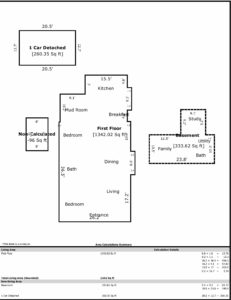Let’s address real estate and the effect of the appraisal – and how the appraisal is influenced by size and comps (comparable sales). We use to say that a home is worth what someone is willing to pay. Now we say that a home is worth what someone is willing to pay AND the amount for which it will appraise.
 When pricing a home before it goes on the market, I try to pull comps in the same manner that an Appraiser will.
When pricing a home before it goes on the market, I try to pull comps in the same manner that an Appraiser will.
(1) First rule is that they must compare your home to those of similar size. They are not going to compare a 2,000 square foot home to a 5,000 square foot home; nor are they going to compare a home built in 1920 to new construction. The general rule I follow is to pull comps plus or minus 25% square footage of the subject property.
(2) Second rule to consider is the distance from the subject property. All comparable sales must be within one mile of the subject property and most Appraisers will not cross an arterial street unless there is good reason.
I recently had a property listed at 78th & Harvard and wanted to know if the Appraiser would consider a comparable property at 82nd & Harvard, because it was almost an exact match. He said he could consider that property now, but would not be able to in the future, because 81st Street will be the new dividing line between Jenks East and North grade schools. Because Jenks East will be considered superior to Jenks North, crossing that arterial street will not be allowed.
(3) The third rule that Appraisers must follow is to include comps in the last six months. This is more of a challenge when a property is being appraised in April and the Appraiser is viewing comparable sales that closed during the winter months. If there is an exact comp that is 7 or 8 months old, they may be able to defend that exception.
Please remember that the Appraiser does not work for the Seller or Buyer. The Appraiser is looking out for the Bank or Lending Institution. That property is their collateral and they don’t want their client borrowing more money than the property is worth.
I almost always ask my home Sellers to order a “square footage only” appraisal before we put their property on the market. In our MLS (Multiple Listing Service), we must use either the court house records or an Appraisal to advertise square footage. I always recommend Chris Streich 918-284-5750 and he charges $75-$100 for this service. The court house records are rarely correct, and you might as well know the square footage the Bank’s Appraiser is going to consider before you decide on your list price.
A few interesting things I’ve learned over the years . . .

Another client had an area of finished attic space that we thought would be included in the square footage, but the ceiling height was too low. In general, a ceiling height of 7-feet is required to be counted as living space, but there are exceptions if there are beams or if the ceiling is sloped.
A problem we encounter in midtown in our older homes if the inability to count finished basements in the gross living area square footage. It doesn’t matter if the finished basement is in better condition than the main or 2nd floor, it is below grade and will not count. Ouch.
Source: NationalAppraiserRoster.com:
ANSI simply states: The below-grade finished square footage of a house is the sum of finished areas on levels that are wholly or partly below grade.
FHA/HUD guideline also succinctly states: Finished basements and unfinished attic areas are not included in total gross living area.
The Fannie Mae Selling Guide is very clear on what is a basement or below grade stating: A level is considered below-grade if any portion of it is below-grade—regardless of the quality of its finish or the window area of any room. A walk-out basement with finished rooms would not be included in the above-grade room count.
Fannie Mae also specifically recognizes that all basements are not created equal and states: Rooms that are not included in the above-grade room count may add substantially to the value of a property—particularly when the quality of the finish is high. The appraiser must report the basement or other partially below-grade areas separately and make appropriate adjustments for them on the “basement and finished areas below-grade” line in the “sales comparison analysis” grid.
The ERC guideline is more nuanced than Fannie Mae, FHA/HUD and ANSI in below grade living areas as it states: When areas that are 50 percent or more above grade are fully finished and equipped with a design and arrangement of windows adequate to provide the “look and feel” of an above-grade-living area, the appraiser can opt to include these areas in the gross living area calculation.
How Realtors MARKET a property is not necessarily how an Appraiser will evaluate a property. It makes sense to me to understand the guidelines an Appraiser must follow before you list a property and set expectations too high.
I recently went on a listing appointment where the tax records report a square footage of 3,500 square feet. Imagine my disappointment to learn that their 1,100 square foot finished basement was included in that 3,500 number. They’ve been paying taxes for 25 years on a 3,500 square foot home which will be viewed by an Appraiser as a 2,400 square foot home. And if the average price per square foot in their neighborhood is $200 per square foot, their home is going to appraise for $480,000 – not the $700,000 these Sellers had hoped for. We will certainly ADVERTISE the home as 2,400 square feet + an 1,100 finished basement, but the reality is that their home is NOT 3,500 square feet.
So, Sellers and Realtors need to educate themselves about the standards and guidelines used by Appraisers unless they are lucky enough to land a cash Buyer. A good resource for all of us to use is the ANSI Standard is the accepted method by National Association of Realtors, which can be found at AccurateHomeMeasuring.com.
Lastly, when an Appraisal comes in below the contract sales price, either party can cancel the contract, but usually the Seller has to reduce the price to the appraised value if financing is involved. Sometimes a Buyer may love a house enough and have the means to pay the difference between the appraised value and contract price, but few Buyers want to pay more than the Appraiser believes the home is worth. Be prepared for that situation if you have improved your home beyond what your neighborhood comps will support.
And if you are in the process of making home improvements, ask your Realtor to stop by and approve your renovations. It’s okay to make improvements from which you will see no return, as long as you know that up front.
So this sums up why and how an Appraisal affects the real estate industry – and why size and comps matter. If you are interested in improving or selling your home, I am happy to further advise you! 918-852-5036
Content written and published by Lori Cain.


